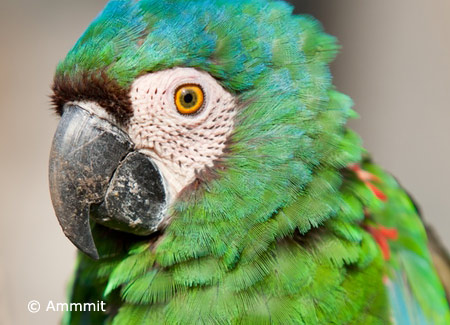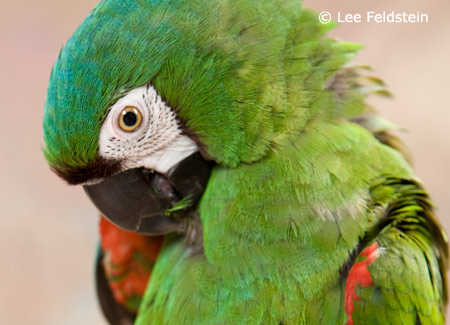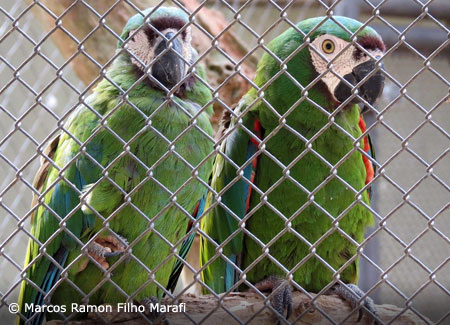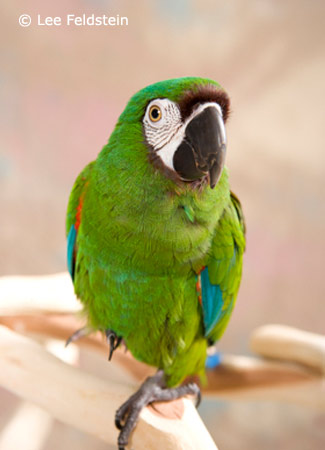[bars]
Common Names: Severe Macaw, Chestnut-fronted Macaw
Scientific Name: Ara severus
Origin: Brazil, Bolivia
Relative Size: 18-19 inches
Weight: 350-400 grams
Average Lifespan: 45-50 years
Egg Clutch: 2-4 white eggs
Incubation: 28 days
Talking Ability: Moderate
General Information about The Severe Macaw

Severe Macaws look very similar to their cousins the Red-Shouldered Macaws. These moderately sized parrots are a little larger then a Sun Conure and larger than the rest of the mini macaw species.
The plumage of this magnificent creature has many shades of greens. When the parrot is resting, it shoulders showcase bright red and blue patches. When the bird is in flight, its long tail and wing feathers are fanned out revealing dull red coloring underneath. The tail is a mixture of iridescent blue, green, and red and this makes up a large portion of the parrot’s size. The wings, particularly the primary feathers, also showcase an iridescent blue color.
[ads]
The head of the macaw is typical of its species. It has white eye patches of skin with tiny black stripes. The top of the head has chestnut brown patches of feathers that fade away to a green color. The eyes are just as attractive as they are usually a mixture of orange, yellow, and grey with large black pupils. The beak and feet are black.
The sex of a Severe Macaw cannot be identified by visual observation. The only reliable way of determining the sex of a Severe Macaw is through DNA testing or examination with an endoscope. The males do tend to be larger, have a larger skull, and are much more aggressive when breeding. This can be an indication that you may have a male on your hands, but it’s not necessarily so.
Severe Macaws in the Wild
Sever Macaws are native to South America. These parrots can be found in Panama, Brazil, and Bolivia. They thrive in the forests, but due to deforestation, have had to adapt to open woodlands and savannahs. Sometimes these birds can be seen damaging and eating crops. Because of this, many farmers regard these animals as pests. Locals and tourists, however, enjoy them as beautiful creatures of nature. Thankfully, these parrots are not endangered but this can quickly change if deforestation and habitat destruction continues.
In their natural habitat, Severe Macaws spend most of their days exploring, flying, and looking for food with their flock mates. During the early morning hours they are usually seen gathering in large flocks and can be heard for miles away. During this food hunt, they may be seen eating fruits, palm seeds, or blossoms. Many have also been seen feeding on insects. These omnivores eat a variety of foods; although, we don’t necessarily know the full gamut of what other foods they be eating.
Unlike some parrot species, Severe Macaws can be seen flocking with other parrot species such as Amazons, Sun Conures, and other macaw species. This type of behavior is almost always seen when the birds are at clay licks (cliffs) consuming clay. The reason these birds consume clay remains a mystery; however, it is believed the clay removes parasites or toxins consumed by the parrot throughout the day. It is also believed the clay offers the birds minerals not found in fruits, blossoms, or insects. Whatever the reason may be, these birds will ingest clay on a regular basis.
During the breeding season, these parrots will branch off into pairs and look for cavities in dead trees, or holes made by mammals in healthy trees to raise their young. Once the female finds a cavity that is safe from predators, she will spend some time inside the nest expanding the cavity and prepping the nest for her offspring.
Both male and female partake in the raising of their young. The female will incubate the eggs while the male helps to feed the hen and the chicks. Once the chicks hatch it is a nonstop grueling schedule of feeding the chicks. Most baby macaws will fledge around 2 ½ months and wean around 10 -12 weeks.
Severe Macaws in Captivity

Just recently, Severe Macaws have joined the ranks of other birds being kept in captivity. At one time, most of the breeding stock was acquired through the importation of wild specimens. This has since changed, and most Severe Macaws bred today are from captive bred generations. This means these parrots are not domestic and will retain much of their natural behaviors.
Mostly, these birds are in captivity through excessive trapping and importation. Thankfully, these birds are no longer imported into the United States and those that have been brought in are through prolific breeders.
These parrots are not too difficult to come across and can be purchased in pet shops, bird shows, or local breeders. These mini macaws are popular due to their friendly disposition and most likely will continue to grow in popularity in the future.
Severe Macaws as Pets
Personality wise, these birds are fantastic. Though they have not had hundreds of years of selective breeding to domesticate their personalities, they still make fantastic pets if handfed and well socialized at a young age. They are very curious creatures, so they need a lot of mental stimulation to remain happy and healthy. These birds should be given puzzles, games, toys, and interacted with on a daily basis to ensure they do not become bored.
Most Severe Macaws form monogamous bonds and need “flock” time with their family. These birds do not do well if kept isolated from the family and some even become neurotic if their mental needs are not met. An owner looking to purchase a Severe Macaw should plan on integrating the bird into their life to ensure all emotional and cognitive needs are achieved.
In general, most Severe Macaws don’t’ like excessive touching but every bird is different and has its own personality. Gauge your bird to see what works best. These birds do enjoy being petted alongside the back of their necks, along their beaks, or around their eyes. These birds are perfectly content sitting on their owner’s shoulders while a person does chores or even being placed on a bird stand with the owner nearby.
Any jewelry or shiny objects will quickly amaze this curious parrot. For this reason, all chains, earrings, watches, or bracelets should be put away before handling as they might break if the bird decides to play with them.
Talking and Noise Level
Though these parrots fall into the Mini Macaw category, they are loud considering they are in the smaller macaw family. They do not make great apartment pets. If you decide to purchase one and you live in an apartment, it may be a good idea to discuss with your neighbors beforehand as the birds are noisy. The loud shrill sounds can easily be heard a few houses down and are to be expected during early morning hours, noon, and before sunset. This is what they do in their natural habitat.
If a Severe Macaw is continually screaming for its owner to hold him, this should be ignored. The bird is reacting to the only way it knows to get your attention. It’s best to give the bird attention during its quiet moments so that it realizes that this works best. Unfortunately, many times an owner will give in to the incessant screaming bird in order to quiet it down; however, this attention usually works opposite and the bird will continue to make noise because it knows it works. When the noise becomes unbearable, an owner may decide to sell or give the bird away and this is regrettable for the bird.
Under any circumstances, an owner should never flick the bird’s beak, spray the bird with water, or yell at the bird when it becomes noisy. These tactics only make the problem worse and parrots do not understand this type of punishment. Instead, the owners should focus on something more positive the bird does and reward the parrot during these times. Eventually the bird will recognize that this positive behavior works best.
Though these parrots may be loud, generally they are the best talking of all macaws. A Severe Macaw can talk with clarity and most do pickup large vocabularies. They have high pitched voices that are delightful to hear.
It should be said that buying a parrot for its talking ability is not the best thing to do as some parrots may never learn to talk and an owner may be disappointed. Instead, chose the bird for its loveable and pleasing personality, and if he begins to talk then it’s a plus.
Breeding Severe Macaws

Breeding Severe Macaws is not that difficult. Though it’s true these birds need to be given time for bonding with each other, it does not take that much effort to get the birds to breed successfully. It is always recommended not to use pet birds in a breeding program, as once tamed, they don’t usually breed successfully. The best candidates are those who have been exposed to other Severe Macaws and have lived inside an aviary setting all their lives. Some owners insist that their pets make good breeders and can be handled throughout the breeding season; however, this can work in a counter way. It is more likely that the once tamed bird will become aggressive and lose its docile personality; however, remember that every bird is unique.
When the spring and early summer breeding season approaches, a bonded pair will become more vocal. During this time a female will look for a nesting site to raise her young. In most cases, this is usually a vertical nesting box made of wood or metal placed in the cage by breeders.
The inside of the box should have a ladder to ensure the female can climb up and down without damaging her eggs. The bottom of the box should also have some sort of bedding such as pine shaving or wood chips that are not toxic to the parrot; however, some female birds choose to remove the wood shavings. If this should happen, the owner should replace a few handfuls back into the nesting box until the first egg is laid as this keeps the egg from rolling around and getting damaged.
The box should also be positioned so the owner has easy access to the eggs and the chicks. Most boxes are suspended outside the cage with doors that open on the side of the box or the top. On average, most nesting boxes are 2 feet in height, 1 foot in width, and 1 foot in length.
Once the birds mate, the female will start to lay her eggs. The eggs are laid every other day until her clutch is complete. On average, a typical clutch will consist of between 2 to 4 white eggs. The female will incubate the eggs for 27 to 28 days. Just before hatching, the chicks will make a tiny hole from inside the egg in order to breath. This alerts the mother of their arrival. Some mothers will eat the shell to help regain the lost calcium while incubating, yet others totally ignore them. Upon hatching, a breeder should remove the shells, if any are left, to ensure they do not “cup” around the other eggs as this could prevent the other chicks from not hatching due to suffocation.
Once the chicks do hatch, the mother will remain with the chick for several weeks until they can produce their own body warmth and the baby bird’s food demands increase. Until then, the male will work tirelessly to ensure the babies, hen, and himself are fed. This stressful time lasts until all the babies are weaned; roughly 70 days.
If a breeder wishes to hand feed any of the babies, all chicks must be removed when the youngest is about 10 days old. Chicks that have been removed for hand feeding will most likely take longer to wean and this is normal. During this time the owner should be patient and never starve any of the chicks in order to accelerate the weaning process. Rather, the chicks should be fed more often in small quantities with an array of foods placed inside the weaning cage.
Once the babies have mastered their flight skills, the owner should then clip the bird’s wings as they may be more difficult to handle and want to fly away. A skilled flier will be able to fly without hitting walls, maneuver up and down, hover, and make a graceful landing.
Choosing the Right Cage
There are so many wonderful cages on the market today that there is a style for almost any owner. These cages come in many colors, shapes, and sizes. The most important thing when purchasing a cage is that it should be usable and safe for a pet Severe Macaw. A good cage will allow the bird to move about without any part of its body, tail included, touching the cage bars. When the parrot flaps its wings, they too should not touch the walls of the cage.
Though these parrots might seem small compared to their larger macaw cousins, they are very active and they need ample room to feel happy and be healthy. In the wild these birds have the luxury of flying about, foraging, and playing. Captive parrots don’t have this luxury, so it’s even more important to get their cages as large as an owner’s budget can afford. In addition, try to get a cage that will last a lifetime.
The cage should be powder coated or made of stainless steel. Cages that are galvanized or have bars that contain zinc should never be used as this is toxic for the bird. The bars should not be spaced more than an inch apart to ensure the parrot’s head does not become stuck.
All food and water bowls should have their own doors for easy access. The bottom of the cage should have a grill to keep the parrot away from its own droppings where harmful bacteria and moldy food can reside. Many grills will slide out and can quickly be washed and disinfected. A slide out tray beneath the grill is just as important. This tray allows the owner to daily cover and change the bottom of the tray with newspapers. It is also great for disinfecting and making sure the bird cage remains clean.
Toys for a pet Sever Macaw

Severe Macaws need a great deal of toys to keep them busy while their owners are out. It is important the toys not only be focused on chewing, but other actives such as foraging or puzzle solving. There are now many toys on the market that encourage all these natural behaviors and they all should be used. It’s also important to rotate the toys regularly to ensure the parrot never becomes bored. All too often, many owners make the mistake of keeping the same toys inside the cage and the parrot loses interest. Foot toys, large wooden blocks, unprocessed leather, and chains make wonderful items. Today, there are many of these on the market.
A play stand is ideal for any Severe Macaw to play outside its cage. Because these parrots like to chew and are destructive in this way, fresh wooden branches from fruit trees or non-toxic tress can be used to add more elements to the play stand. All owners should train their parrots to remain on the bird stand. If a parrot tends to wander off, it can quickly find itself in harm’s way by getting into things that are unsafe. This training technique is achieved by simply picking the bird up and placing him back on its stand should it try to fly off or wander about.
A proper Diet for a Severe Macaw
Feeding a Severe Macaw a healthy diet is essential if an owner wants to ensure their macaw is happy and healthy. Forget about the inaccurate thinking that feeding a parrot only seeds was sufficient. Remember that these birds come from the rain forest and eat an assortment of foods. Experiment with the bird’s diet. In the wild these birds eat all kinds of foods and it is important we try to mimic their natural diets. This makes for a more healthy bird.
Occasionally, macaws should be given palm nuts as their beaks are designed to eat the outer fleshy parts. These nuts contain oils and enzymes the birds require. A base diet of pellets and seeds should also be given, but it is important they be rotated so the macaw does not just develop a taste for these, or worse yet, totally hate them. They need to also be fed fresh fruits and vegetables on a daily basis.
Fruits such as oranges, kiwis, mangos, apples, grapes, peaches, and plums are great for the bird. Many of these fruits can be cut up into squares and presented like a kabob to the macaw as it will enjoy playing with the fruit and sampling all the flavors.
Vegetables such as squash, pumpkin, corn, carrots, kale, spinach, and celery are usually enjoyed by most parrots. These vegetables can be cut during dinner and placed into the refrigerator for later feedings. In this way, you don’t have to go out of your way just to cut fruit for your parrot and it saves time. Other healthful items are beans and legumes; although, beans and legumes should always be cooked before feeding them to your bird.
If a Severe Macaw is cared for properly, and fed a variety of different foods that are healthy it can live to a rightful age of 45 or 50 years.
[ads]
